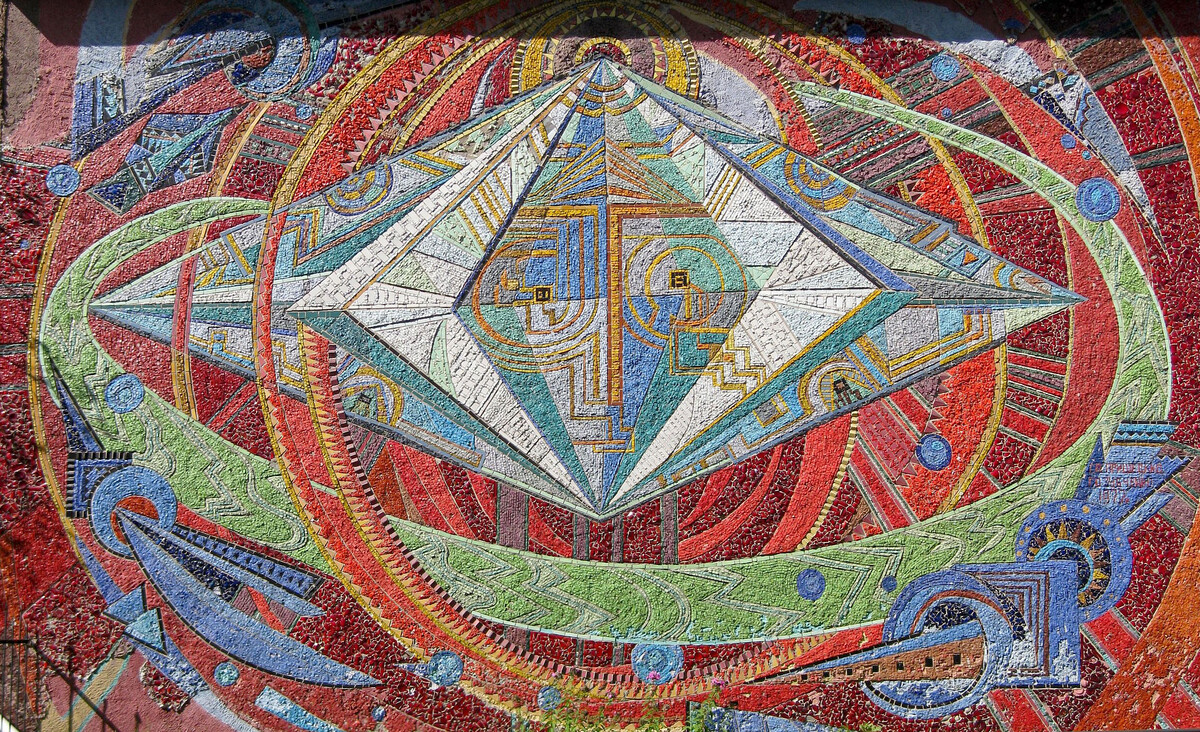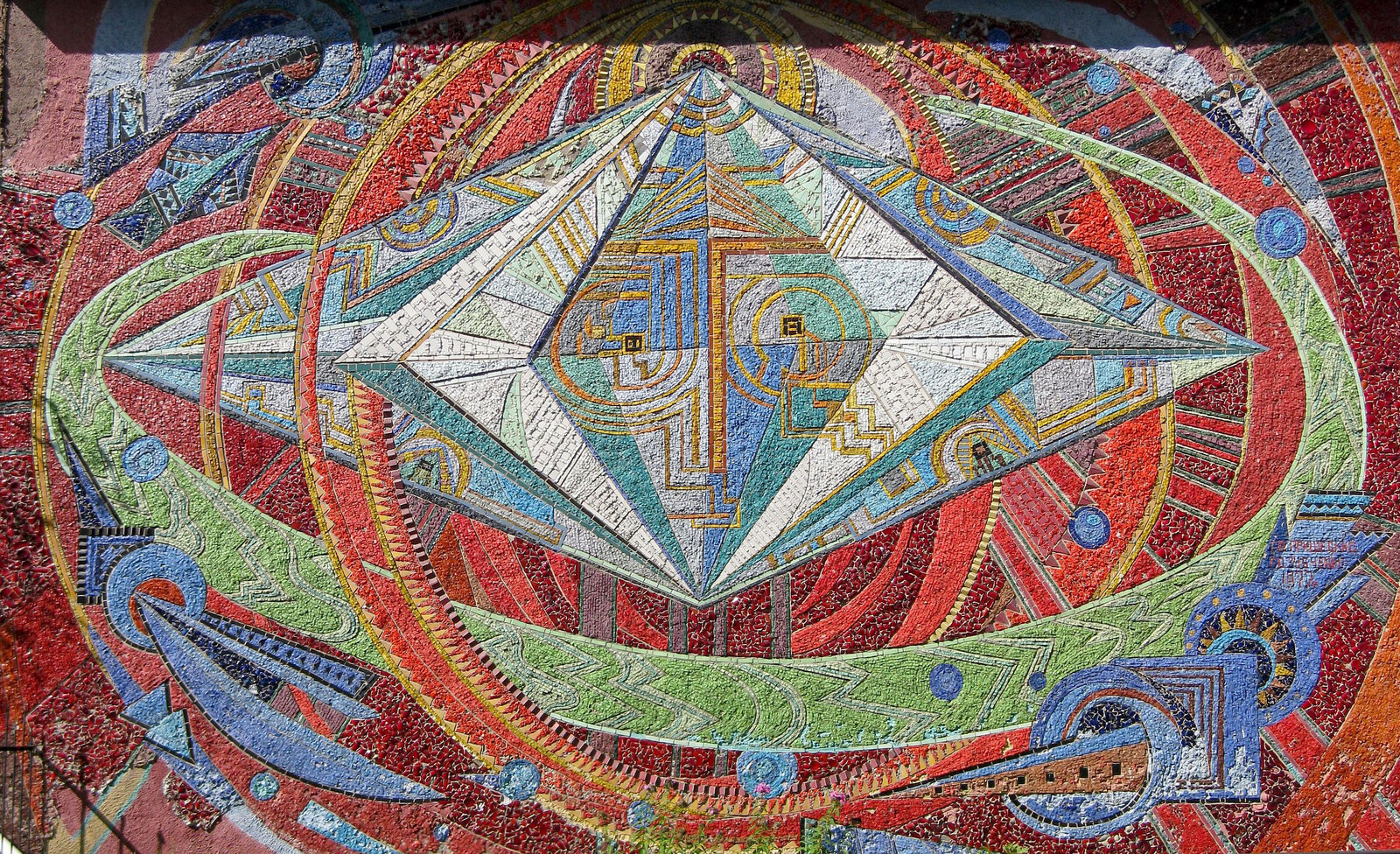Notes for a Film
On September 26, 2014, a blog post on a Ukrainian news website claimed to report on an overheard phone conversation between someone fleeing the war-torn region of Donbas and a friend who had stayed behind in the occupied city of Donetsk. They were discussing the ongoing battle for the airport then being fought between the Ukrainian army and Russian-backed forces. According to the blog post, a person from Donetsk claimed that the Ukrainian combatants fighting for the airport were referred to by their adversaries simply as “cyborgs.” This was, allegedly, due to their “inhuman” ability to survive in the airport debris under constant shelling, and fight back despite a lack of ammunition and resources.1
The blog post went viral, and very quickly the word “cyborg” became a widespread designation for every Ukrainian soldier who fought in the Donetsk airport. Ukrainian president Petro Poroshenko and other officials contributed to the establishment of this new myth by using the term without quotation marks in their official addresses, as if insisting on its nonmetaphorical status. The battle for Donetsk airport went on for 242 days, and its “cyborg” mythology helped boost the morale of Ukrainian troops and media audiences alike.2 As the conditions for the besieged fighters at the ruined airport grew more harsh and intolerable, their newly acquired status as “cyborgs” became helpful—despite the fact that their extremely poor-quality, scarce ammunition was a far cry from the cyborg-related technological imagery disseminated in mass culture.3
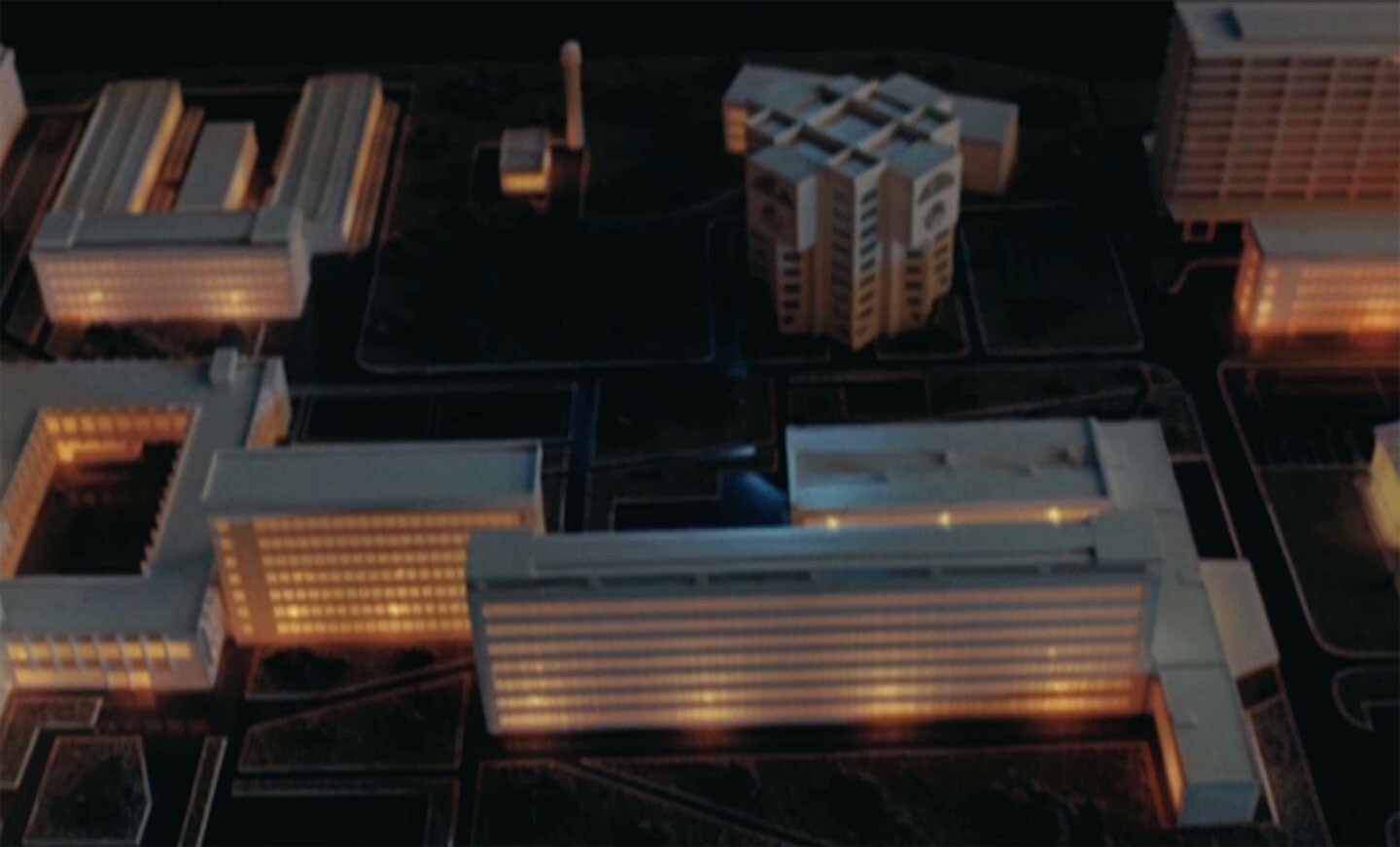

An architectural model of the entire campus project for the Institute of Cybernetics in Kiev, which was only partially built.
Let us rewind thirty years to the early 1980s, when the coal-mining area of Donbas was still part of Soviet Ukraine. The region was an experimental site for the attempt to create a pioneering cybernetic system that would automatically manage the economy and the infrastructure of the Soviet state. This experiment was called ASU-DO, or “Automated System of Control of the Donetsk Region.” It relied on a local computing center to run a three-tiered hierarchy of command: at the regional level, the city level, and the district level. It oversaw functions as diverse as steel production and trolleybus traffic in Donetsk, in addition to financial accounting and information analysis on “labor quality.” The Donetsk system was a pilot project for the Soviet Union’s statewide computer-based information management system, designed by the computer engineer Viktor Glushkov, the founder and director of the Institute of Cybernetics in Kiev.
Viktor Glushkov’s cybernetic system is now sometimes referred to as “the Soviet internet.”4 For some (in the post-USSR) it is a source of nostalgic historical revisionism in the age of “Cold War 2.0”; for others (in the “post-West”), it is a geeky artifact from an alternative history in which the twenty-first century was not always doomed to resemble a dire cyberpunk novel. The problem with Glushkov’s “internet” is obvious: it didn’t exist. Moreover, it’s not even clear if its alleged prototype—the Donetsk cybernetic system—was ever more real than the cyborgs of Donetsk airport. In fact, the only known description of this system comes from an obscure 1980s documentary film about Viktor Glushkov, unearthed in a film archive in Kiev. For sure, Soviet documentaries are not known for being the most reliable historical sources. Still, bearing in mind that those films were sometimes meant to construct reality rather than represent it, it’s worth taking a critical look at the knowledge they might provide about the global significance that Glushkov’s projects continue to have in our so-called post-truth era.


Viktor Glushkov at the Institute of Cybernetics in Kiev, date unknown.
Born in 1923, Viktor Glushkov was raised in East Donbas. His talent for math and technology was evident from early childhood, but his scientific career was thwarted when Nazi Germany, on the day of his high-school graduation, invaded the USSR. Glushkov spent the war years under Nazi occupation and was only able to enter the academic world in the 1950s, when he proposed a solution to “Hilbert’s fifth problem,” one of the fundamental questions in mathematics at the time, which concerned the question of whether continuous groups are automatically differential groups. Glushkov then moved to Kiev, a city where the first computer in continental Europe was constructed in 1950, under the supervision of Soviet computer engineer Sergei Lebedev. Meanwhile, the de-Stalinization of Soviet science in the mid-1950s led to an increase in interest in cybernetics, which had previously been criticized under Stalin as bourgeois pseudoscience.5 Viktor Glushkov was among those who saw in cybernetics a tool for transitioning to a real communist society, liberated from both the domination of capital and the overgrown Soviet bureaucracy. To that end, Glushkov believed that cybernetics had to be freed from the monopolistic control of the military, which tended to limit the scope of cybernetics to its original WWII task of calculating missile trajectories.6
In 1962, the same year Glushkov founded the Institute of Cybernetics in Kiev, he proposed the first model of what would later come to be known as “the Soviet internet”; in classic bureaucratese, he titled it the “National Automated System for the Administration of the Economy.”7 His idea was to link all Soviet regions and branches of industry via a network of computing centers that would program and manage the socialist economy. The assumption was that the possibilities opened up by cybernetic data management would serve the socialist economy much better than the capitalist one: in the latter, the free flow of economic information is constrained by competing private interests and intellectual property, which do not exist in the former. By 1964, Glushkov’s proposal had reached the top levels of the Communist Party apparatus. With the Soviet economy in evident need of reform, it had a good chance of being implemented. Ultimately, the party leadership was deterred by the projected cost of Glushkov’s system, which would consume, according to its author, more funds than the Soviet space and atomic industries combined. In 1965, Glushkov was outmaneuvered when the Soviet leadership adopted a liberalization plan pushed forward by the economist Yevsey Liberman, who insisted that his plan, unlike Glushkov’s, would cost only as much as the paper it was printed on.
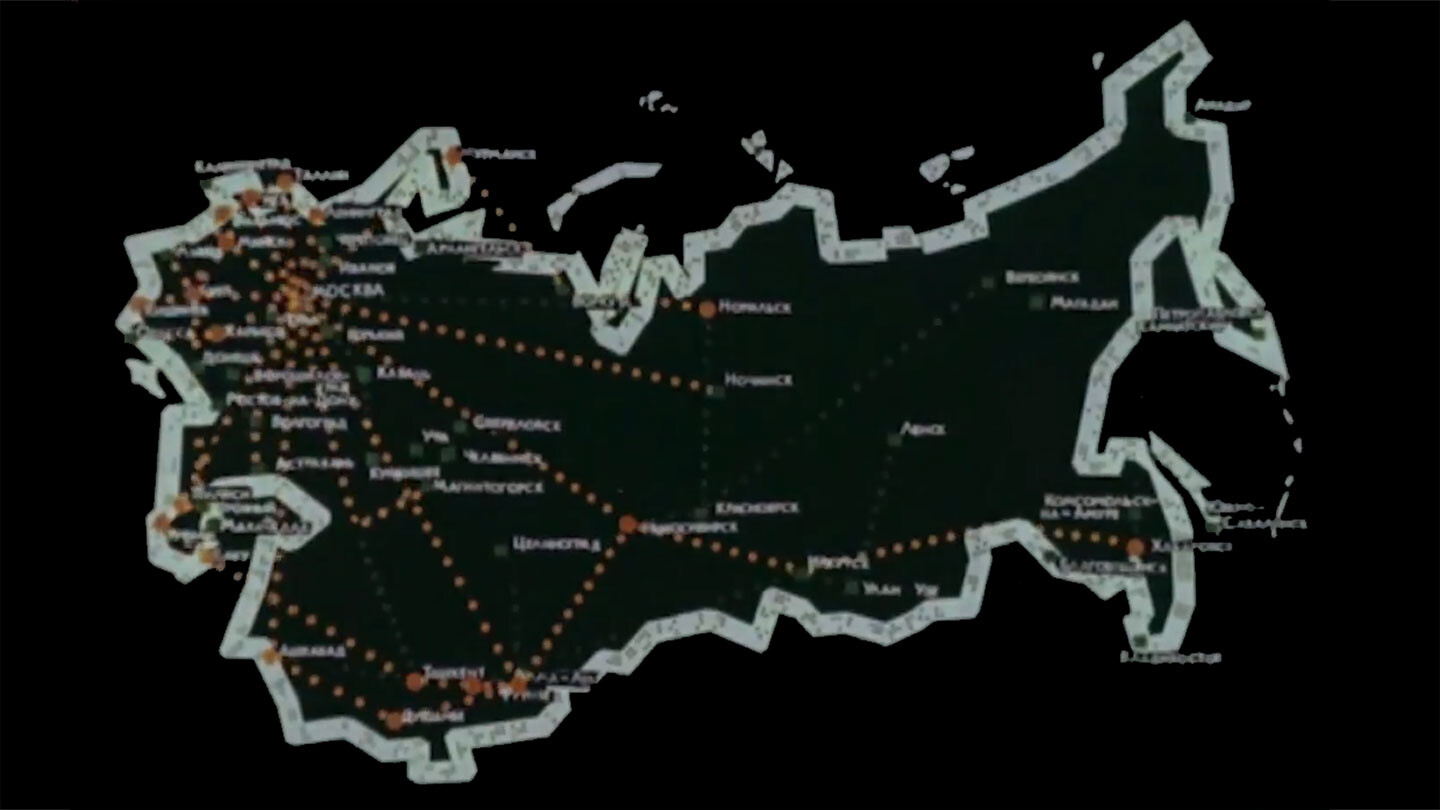

A map of the projected OGAS (National Automated System for the Administration of the Economy) network shows its ambitious breadth and complexity.
Glushkov’s personal and professional trajectory was defined by the Cold War competition between superpowers. His network project was given a new life in 1968, when the Soviet leadership learned that the US had successfully deployed the first prototype of a computer network (ARPANET). Recalling the outspoken computer scientist from Kiev who five years earlier had suggested doing what the Americans had now done, the Politburo requested Glushkov’s presence at a 1970 top-level meeting to consider the nation-wide implementation of his system. The meeting was a disaster.8 The project of an all-encompassing system of information management was dropped, and Glushkov was advised to concentrate on smaller-scale “automated management systems” for particular branches of industry.
But Glushkov was always working on multiple side projects, and one of them turned out to be particularly fateful. Between 1964 and 1974, the Soviet Union had been constructing the world’s longest oil pipeline, which would transport Siberian oil to East Germany, Poland, Czechoslovakia, and Hungary. This was a project of utmost political importance, reflected in its straightforward title: Druzhba (Friendship). Glushkov was tasked with devising an automated system that would operate the pipeline; it turned out to be one of the largest networks ever created. Glushkov scholars usually overlook his work on the Druzhba network, regarding it as just one of the many mundane tasks that the great scientist was ordered to perform. In fact, it is where Glushkov’s unrealized vision for a cybernetic network became a reality. Even though the Druzhba pipeline network was smaller in scale than Glushkov’s original idea for a statewide network, it was in this project that he came closest to implementing his ideas. Initially, Glushkov wanted to build a network through which information would circulate; instead, he built a network through which fossil fuel circulated.
Glushkov’s work on the Druzhba network was depicted in a four-part TV series based on a novel by Soviet Ukrainian writer Pavlo Zahrebelnyi, which fictionalized Glushkov’s life. In the film, titled Acceleration, the novel’s plot was updated to portray a group of cyberneticists working on a gigantic pipeline network for natural gas. This network was indeed under construction in the Soviet Union starting in 1960s, and the gas pipeline was the subject of a major Cold War dispute for nearly two decades. Right after the USSR started negotiating with West Germany about the construction of the pipeline, the US tried to prevent the deal from taking place. Finally, in the early 1980s the pipeline network was completed with the help of loans from German and Japanese banks. To this day, this pipeline network brings natural gas from Siberia to Europe.
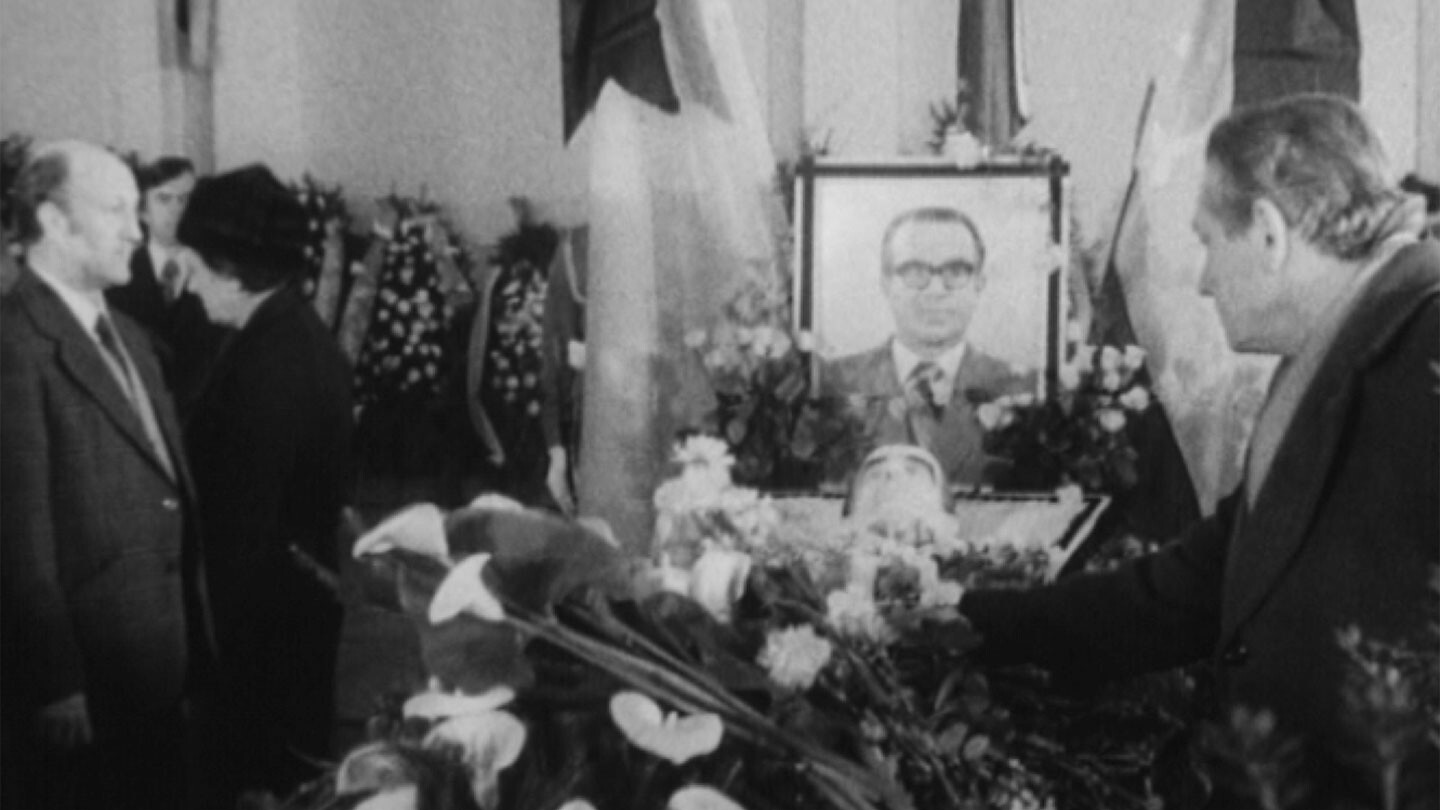

Funeral ceremony in honor of Viktor Glushkov, 1982.
In the Soviet popular imagination, Glushkov became a hero, inspiring novels and feature films. The filmmakers at Kiev Scientific Film Studio produced numerous documentaries on Glushkov’s work, many of which were directly commissioned by his Institute of Cybernetics. These works represented the scale of the Soviet scientific imaginary of the time, which was enthralled by the idea of technological acceleration and the merging of humans with machines. In an interview from the late 1970s, Glushkov spoke about a newly developed technology that could record the biocurrents of the human brain. He believed it would enable the creation of a new, cybernetic iteration of the human being, thus paving the way for human immortality. Together with renowned surgeon Mykola Amosov, he developed the discipline of biocybernetics. Glushkov boasted of taking the medical histories of staff members of the Institute of Cybernetics and feeding them into a machine that then offered a prognosis for their future health; in Glushkov’s vision, this was cybernetic healthcare for the future.
But then something totally unexpected happened. Glushkov’s own health started to fail. The best Soviet doctors tried to come to his rescue, but none of them could figure out what was going on. In early 1982 he was diagnosed with a rare form of brain cancer and died several weeks later, at age fifty-eight. Leonid Brezhnev, the head of the Soviet state for eighteen years, died later that same year. His successor, Yuri Andropov, passed away little more than a year later, and his successor, Konstantin Chernenko, died in early 1985. All three men were in their late seventies. For all the talk of accelerating technological progress, the Soviet Union was trapped in a dynamics of deceleration dictated by the ailing gerontocracy that ran the country.
Soviet society was hypnotized by the notion of technological acceleration at the same time as it was overwhelmed by frustration and boredom. The economy was weighed down by a constant state of crisis, yet no credible scenarios of reform were deemed acceptable in public discourse. The system seemed like it would last forever, even as it was becoming difficult to imagine what the future would look like if the status quo persisted.9 The political system showed signs of imminent collapse, yet no viable alternative was anywhere in sight, apart from the idea of more of the same—more growth, more productivity, more speed.10 In 1985, Mikhail Gorbachev came to power, proposing a program to radically overhaul the economy and society. His plan was based on three notions: perestroika, glasnost, and uskorenie. Perestroika and glasnost have entered the English language as “restructuring” and “openness,” respectively. But the third part of this triad, uskorenie, is not at all well known: it means “acceleration,” which, according to Gorbachev, was a crucial counterpart to perestroika and glasnost.11 Rather than accelerating “real existing socialism,” Gorbachev’s uskorenie furthered the sublation of Soviet communism into post-Soviet capitalism.
Historians like to talk about how the collapse of the Soviet bloc in 1989 coincided with the rise of the internet. But the implications of this coincidence are far from clear.
Some see it as an optimistic scenario in which information flows were liberated from the constraints of totalitarianism. For others, the egalitarian promise of the early World Wide Web constituted a novel and badly needed horizon of real democracy after the perceived failure of every alternative to Western capitalism. As the internet has become a competitive playground for libertarian monopolies, the idea of the web as an alternative to market society has been discredited. The former scenario—the internet as a counterforce to authoritarianism—though equally misleading, deserves more scrutiny. In their book The Red Web (2015), Andrei Soldatov and Irina Borogan describe the circumstances that led to the establishment of the first internet connection between the Soviet Union and the West. Soldatov and Borogan stress the importance of the fact that the first nonmilitary and nonacademic e-mail from Russia was sent on August 19, 1991, during the attempted military coup that ultimately led to the dissolution of the USSR.12 What evades their analysis, though, is that the discourse of this email, sent to the discussion list talk.politics.soviet, contains in a nutshell the political agenda of a resurgent nationalist Russia: the email said, “Communists cannot rape Mother Russia again!” The arrival of global information networks in the former USSR was far from ideologically neutral: it became a tool of neocapitalist restoration, accompanied by the rise of nationalism.
The epoch of Glushkov has ended, and the world looks radically different than anything the pioneering cyberneticist could’ve imagined. His name has fallen into oblivion—along with the particular philosophy of truth that he tried to apply in his scientific work. In numerous interviews, he formulated this philosophy as follows: “If you feed the truth into the machine, this truth will accelerate human capabilities. But if you feed deliberate lies into the machine, these lies will multiply and destroy the whole thing.” Glushkov meant that his cybernetic network would function properly only if the economic information fed into it was accurate and not distorted by corrupt officials—which he knew was happening more often than not. But Glushkov was also trying to stress the idea that technology is not neutral and abstract. Rather, a certain kind of data—which he referred to as “the truth”—can animate it in almost miraculous ways, expanding human capabilities. But the same technology can also accelerate lies, leading to disasters on an unprecedented scale. This dichotomy has found a tragic application in Glushkov’s own work. The networks of his design, originally intended to carry information, are now used to carry fossil fuels. Apart from leading to ecological disasters, these fossil-fuel networks have contributed greatly to the accumulation of wealth in the hands of kleptocratic Russian elites, who are using it to support the global rise of a nationalist, revisionist politics, with the help of information warfare made possible by cybernetic technologies. To dispel these “deliberate lies,” we should start by feeding our machines the truth about how these technologies became what they are today. Otherwise, we will be caught in a vicious circle of dispossessed “cyborgs” annihilating each other with antediluvian weapons in wars provoked by hi-tech information flows.
The original post, in Russian, is here → (“The Donetsk Airport is Being Defended by the Cyborgs!”). This remains the only post ever published by its author, and no information on this person is available on the web.
The war in East Ukraine, sparked by Russia’s annexation of Crimea in 2014, generated a great deal of cyber-based mythology on both sides. The most significant example on the Russian side is probably CyberBerkut, a pro-Putin hacker group whose name glorifies the notoriously violent riot police that attempted to suppress the Maidan uprising in Kiev.
In his book Cyber-Proletariat (2015), Nick Dyer-Witheford describes “the coexistence in contemporary capitalism of extraordinary high technologies and workers who live and die in brutal conditions often imagined to belong in some antediluvian past. This coexistence is also a connection. Mines and artificial technologies seem to belong to different worlds, but they are strongly linked.” The story of the “cyborgs of Donetsk airport” could expand this framework to include the ongoing militarization of the internet.
See Ben Peters’s superb How Not to Network a Nation: The Uneasy History of the Soviet Internet (2016), the first book-length English-language account of Viktor Glushkov’s computer network projects. The present essay owes a great deal to Peters’s in-depth research in previously unavailable archives in Moscow and Kiev. Still, it must be noted that the term “Soviet internet” is as simplifying as it is eye-catching: it reduces Glushkov’s pioneering research into what we now know as e-governance, artificial intelligence, and network theory to a retroactively imposed catchphrase. See also Slava Gerovitch, “InterNyet: Why the Soviet Union Did Not Build a Nationwide Computer Network,” History and Technology 24, no. 4 (December 2008): 335–50 →.
Peters, How Not To Network a Nation, 29–32.
The science of cybernetics emerged, to a large extent, from the military industries of WWII. Norbert Wiener, who is credited as the founder of cybernetics, worked on the automated aiming and firing of antiaircraft guns during WWII—research that helped him develop the new discipline of cybernetics. Soviet promoter of cybernetics, military officer, and engineer Anatoliy Kitov, who was the first to bring Wiener’s theories to the USSR, had a background in artillery as well. The significance of wartime experience for the generation of scientists who developed cybernetics in the USSR cannot be overestated. When Svitlana Matviyenko and I asked Borys Malinovsky, one of the pioneers of Soviet cybernetics (and, lately, its leading historian), how he become interested in cybernetics, he replied with a lengthy account of his military service during WWII.
The proposed system was referred to in the Soviet Union by its abbreviated title—OGAS, for “Obschegosudarstvennaya Avtomatizirovannaya Sistema Upravleniya.”
For a detailed account of this fateful event, see Peters, How Not to Network a Nation, 161–66. Long before the globe became more interdependent than ever due to overlapping information networks, the fate of the Soviet network was probably defined by an event that happened in a distant part of the world prior to the meeting: on September 28, 1970, Egyptian president Gamal Abdel Nasser died, and Leonid Brezhnev, who went to attend his funeral, had to miss the Politburo meeting where Glushkov’s project was discussed. This emboldened the hardline critics of Glushkov, who used the meeting to ridicule and discredit his ideas.
Alexey Yurchak’s Everything Was Forever, Until It Was No More (2005) analyzes this social condition in the late USSR. It is a frighteningly timely read today.
In the wake of Trump’s election, the sinister implications of right-wing accelerationism are increasingly coming to light. See Yuk Hui, “On the Unhappy Consciousness of Neoreactionaries,” e-flux journal 81 (April 2017) →; and Shuja Haider, “The Darkness at the End of the Tunnel: Artificial Intelligence and Neoreaction,” Viewpoint Magazine, March 28, 2017 →. At the same time, more and more parallels are being drawn between the final years of the USSR and the current state of Western societies. In light of this, it’s definitely worth paying more attention to late-Soviet accelerationism, which is an illuminating analogue to modern-day affirmative accelerationism.
Yuk Hui may be right to call Deng Xiaoping the world’s greatest accelerationist, but Mikhail Gorbachev is a close second. After all, his notion of acceleration brought down the Soviet Union in five short years. See Hui, “On the Unhappy Consciousness of Neoreactionaries.”
Many thanks to Svitlana Matviyenko for drawing attention to this episode and to the work of Soldatov and Borogan in general.
This essay is a loose synopsis of the film The Great Accelerator, an in-progress documentary film about the life and work of Viktor Glushkov. All images are courtesy of the author and have been collected during research for the film.
I’m indebted to Svitlana Matviyenko for sparking my interest in the subject and for her feedback on this essay. This research would not have been possible without the groundbreaking writing of Ben Peters, Andrei Soldatov, and Irina Borogan, to whom I’m thankful for feedback on my work. Many thanks to Boaz Levin, Hito Steyerl, and Vera Tollmann at the Research Center for Proxy Politics for the chance to present and discuss this research in its early stage. Thank you to Anton Vidokle, Nick Dyer-Witheford, and Lev Manovich for the inspiring discussions, and to Stephen Squibb for the edit. Thanks to my comrades at Visual Culture Research Center, particularly Serhiy Klymko and Ruslana Koziyenko, for support and collaboration on parts of this research. Thanks to Lyuba Knorozok, Boris Mitić, and André Singer for helping to develop the concept of an upcoming film.
